Szybka witryna internetowa jest niezbędna dla zadowolonych odwiedzających i najwyższych pozycji w wyszukiwarkach. Dzieje się tak, ponieważ wyszukiwarki takie jak Google uważają teraz szybkość witryny za ważny czynnik rankingowy.
WP Super Cache to popularna wtyczka, która tworzy statyczne pliki HTML twoich stron internetowych. Oznacza to, że twój serwer nie musi pracować tak ciężko, dzięki czemu witryna wczytuje się szybciej dla odwiedzających.
Używamy wtyczek wydajnościowych, takich jak Cloudflare i WP Rocket, aby poprawić szybkość WPBeginner. WP Super Cache to darmowa alternatywa, która może znacznie poprawić wydajność, zwiększyć SEO i poprawić wrażenia użytkowników odwiedzających witrynę internetową.
W tym artykule przeprowadzimy cię przez proces instalacji i konfiguracji WP Super Cache na twojej witrynie WordPress. Wyjaśnimy każdy krok w jasny sposób, więc nawet jeśli nie jesteś obeznany z technologią, możesz podążać za nami. Pod koniec będziesz mieć szybszą witrynę internetową, którą docenią odwiedzający i wyszukiwarki.
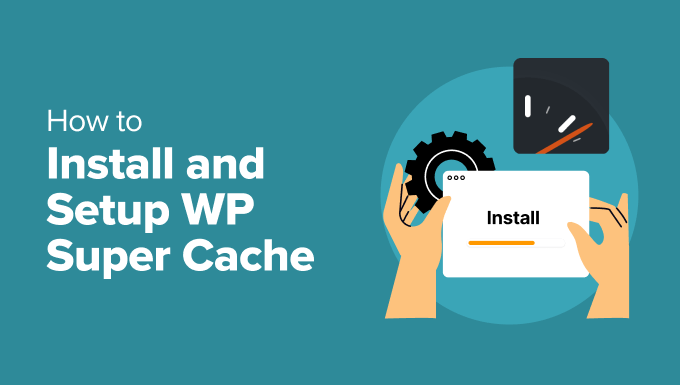
Czym jest WP Super Cache i dlaczego warto z niego korzystać?
WP Super Cache to jedna z najpopularniejszych i najlepszych wtyczek do pamięci podręcznej WordPress. Jest to darmowe narzędzie, które ma ponad milion włączonych aktywnych instalacji.
WP Super Cache tworzy podręczną kopię każdej strony w twojej witrynie w postaci statycznego pliku HTML. W ten sposób za każdym razem, gdy ktoś przejdzie na twoją witrynę, zostanie mu szybko wyświetlona skopiowana wersja, zamiast generować całą witrynę od zera.
W rezultacie szybkość i wydajność twojej witryny WordPress znacznie się poprawiają. Wtyczka pamięci podręcznej pomija wiele kroków za kulisami, aby zapewnić, że twoi odwiedzający nie będą musieli czekać na otwarcie strony.
Poprawi to wrażenia odwiedzających twoją witrynę internetową. Witryna, która wczytuje się szybko, zachęca ludzi do częstszego jej odwiedzania, co prowadzi do większego zaangażowania i konwersji, ponieważ użytkownicy spędzają więcej czasu na twoich wpisach i stronach.
Poza tym, dzięki szybko ładującej się witrynie internetowej, możesz również zobaczyć wzrost Twojego WordPress SEO i rankingów wyszukiwarek. Dzieje się tak, ponieważ Google daje znaczną przewagę szybszym witrynom internetowym, ponieważ wykorzystuje szybkość witryny jako czynnik rankingowy.
Czy jesteś już gotowy, aby skonfigurować WP Super Cache na swojej witrynie internetowej? Do dzieła!
Konfiguracja pamięci podręcznej WP Super Cache – prosty sposób
Pierwszą rzeczą, którą musisz zrobić, to zainstalować i włączyć wtyczkę WP Super Cache na twojej witrynie internetowej. Aby uzyskać więcej informacji, możesz skorzystać z naszego przewodnika na temat instalacji wtyczki WordPress.
Po włączaniu, WP Super Cache powiadomi cię, że pamięć podręczna nie jest włączona na twojej witrynie internetowej w danym momencie.
Aby włączyć pamięć podręczną, przejdź do Ustawienia ” WP Super Cache. Następnie na karcie “Łatwe” kliknij opcję “Włącz pamięć podręczna”. Gdy to zrobisz, kliknij przycisk “Aktualizuj status”.
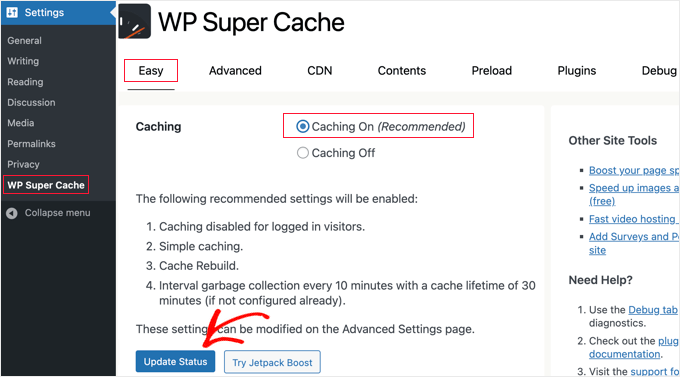
Po włączeniu pamięci podręcznej należy przewinąć w dół do sekcji “Tester pamięci podręcznej”.
Tam należy kliknąć przycisk “Testuj pamięć podręczna”, aby sprawdzić, czy działa.
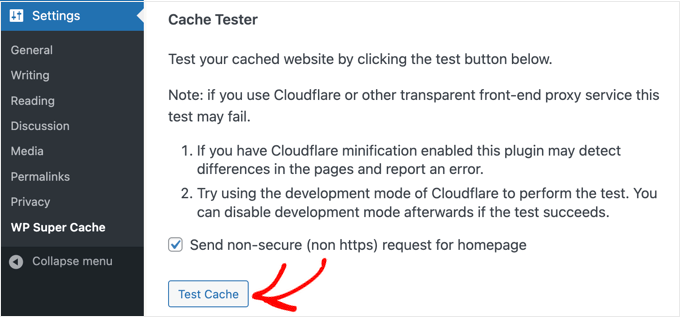
WP Super Cache pobierze twoją witrynę WordPress dwa razy i porówna znaczniki czasu obu stron. Jeśli oba znaczniki czasu są zgodne, oznacza to, że pamięć podręczna działa teraz na twojej witrynie.
Zaawansowana konfiguracja WP Super Cache
WP Super Cache to potężna wtyczka WordPress z mnóstwem zaawansowanych opcji. Opcje te mogą jeszcze bardziej poprawić wydajność twojej witryny i dać ci większą kontrolę nad tym, jak wtyczka zapamięta podręczną twoją witrynę.
Włącz pamięć podręczna
Aby skonfigurować WP Super Cache z zaawansowanymi opcjami, przejdź do karty “Zaawansowane” w ustawieniach wtyczki WP Super Cache. Następnie kliknij pole wyboru “Włącz pamięć podręczną”.
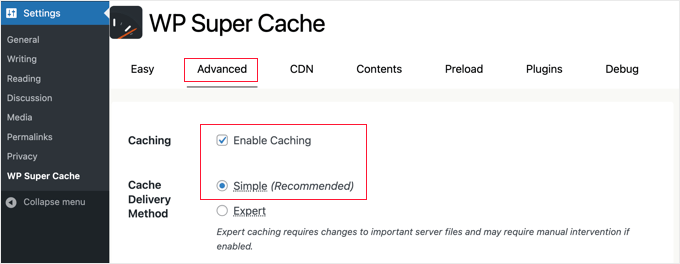
Poniżej opcji pamięci podręcznej znajdują się opcje “Metoda dostarczania pamięci podręcznej”. Zalecamy skorzystanie z opcji “Simple”, jeśli jesteś początkującym użytkownikiem i nie znasz się na edycji plików twojego serwera.
Po wybraniu twojej opcji pamięci podręcznej, upewnij się, że kliknąłeś przycisk “Aktualizuj status”.
Włącz kompresję w WP Super Cache
Kompresja pozwala WP Super Cache obsługiwać pliki w pamięci podręcznej jako pliki skompresowane, co poprawia czas ich wczytywania. Pliki te są mniejsze i mogą być szybciej pobierane przez przeglądarki.
Aby włączyć kompresję, przewiń w dół do sekcji “Różne” na karcie ustawień “Zaawansowane” i zaznacz pole “Kompresuj strony, aby były szybciej wyświetlane odwiedzającym”.

Ponownie kliknij przycisk “Aktualizuj status”, aby zapisać twoje zmiany.
Włącz dynamiczną pamięć podręczna
Jeśli chcesz, aby niektóre części strony internetowej były dynamiczne podczas pamięci podręcznej, WP Super Cache oferuje taką opcję.
Włączenie dynamicznej pamięci podręcznej jest przydatne w niektórych sytuacjach, zwłaszcza w przypadku stron zawierających często zmieniającą się treść. Na przykład, możesz przyspieszyć strony zawierające reklamy, zezwalając na dynamiczną pamięć podręczna.
Aby włączyć tę opcję, należy przejść do sekcji “Zaawansowane” i kliknąć pole wyboru “Włącz dynamiczną pamięć podręczna”.

Pamiętaj, aby zapisać twoje zmiany po zakończeniu.
Konfiguracja czasu wygaśnięcia i zbierania śmieci
WP Super Cache pozwala również ustawić czas wygaśnięcia i częstotliwość usunięcia pamięci podręcznej stron z twojego serwera.
Aby rozpocząć, wystarczy przewinąć w dół do sekcji “Expiry Time & Garbage Collection” w karcie “Advanced”, aby ją skonfigurować.
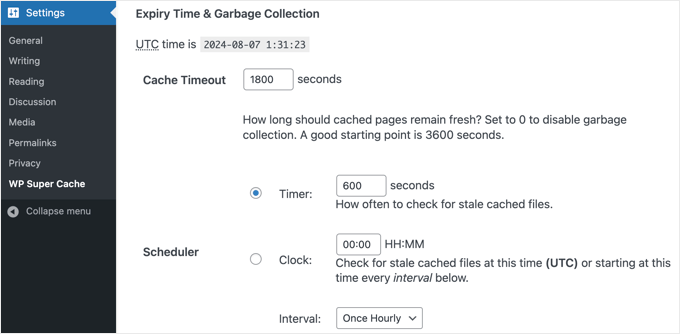
“Cache Timeout” informuje wtyczkę, aby usuwała stronę z pamięci podręcznej i wykonywała nową pamięć podręczną. Wtyczka domyślnie ustawi go na 1800 sekund, co jest świetnym rozwiązaniem dla witryn internetowych o dużym natężeniu ruchu.
Jeśli jednak masz nową witrynę internetową, która nie ma dużego ruchu, to 3600 sekund jest dobrym punktem wyjścia.
Poza tym można zaplanować czas, w którym wtyczka będzie sprawdzać nieaktualne pliki w pamięci podręcznej i usuwać je.
Po zakończeniu dokonywania wyboru należy kliknąć przycisk “Zmień wygaśnięcie”, aby zapisać twoje zmiany.
Określ strony, które nie mają być zapisywane w pamięci podręcznej
Domyślnie wtyczka będzie buforować wszystkie strony w twojej witrynie. Może to zwiększyć rozmiar twoich plików pamięci podręcznej i zużywać więcej zasobów. WP Super Cache pozwala jednak wybrać strony, które nie mają być buforowane.
Możesz przewinąć w dół do sekcji “Odrzucone ciągi adresów URL” na karcie “Zaawansowane”, aby skorzystać z tej funkcji. W polu tekstowym wpisz adres URL stron, których pamięć podręczna nie ma być buforowana przez wtyczkę.
Na przykład, jeśli posiadasz sklep e-handel, możesz wykluczyć strony, na które odwiedzający nie przechodzą zbyt często, oszczędzając w ten sposób zasoby serwera. Może to być strona kasy, strona konta i strona z podziękowaniem.
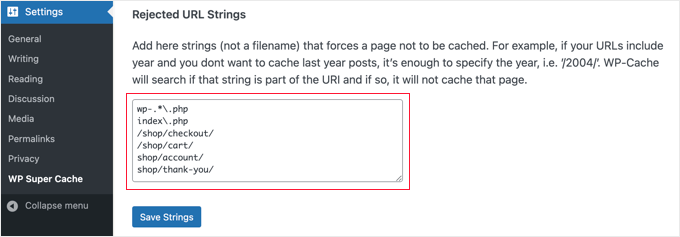
Po zakończeniu nie zapomnij kliknąć przycisku “Zapisz ciągi”.
Konfiguracja pamięci podręcznej WP Super Cache do pracy z twoim CDN
Jeśli korzystasz również z usługi Content Delivery Network (CDN), aby przyspieszyć twoją witrynę internetową, możesz skonfigurować WP Super Cache do współpracy z nią. W przeciwnym razie możesz bezpiecznie pominąć tę sekcję.
CDN to sieć serwerów rozmieszczonych w różnych lokalizacjach geograficznych, która pomaga szybko dostarczać treści twoim odwiedzającym. Aby uzyskać więcej informacji, zapoznaj się z naszą infografiką na temat tego, dlaczego potrzebujesz CDN.
Wskazówka: Zalecamy korzystanie z Cloudflare, ponieważ jest to darmowy dostawca CDN, który jest łatwy w konfiguracji. Zobacz nasz poradnik, jak skonfigurować darmową sieć CDN Cloudflare na twojej witrynie WordPress.
Aby skonfigurować WP Super Cache do pracy z twoją siecią CDN, kliknij kartę CDN w ustawieniach. Następnie zaznacz pole obok opcji “Włącz pomoc techniczną CDN”.
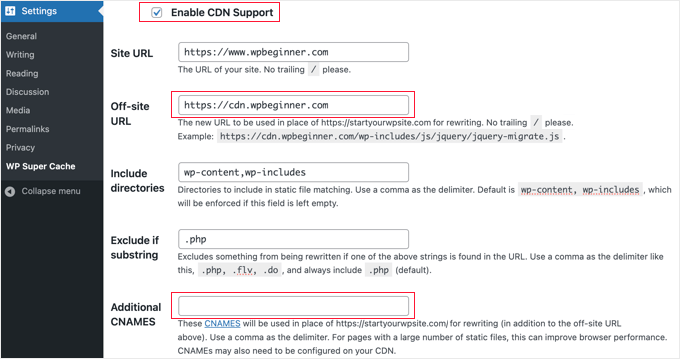
Następnie wpisz swój adres URL poza witryną. Jest to “strefa pobierania” twojego CDN, czyli adres URL, pod którym twoje pliki są przechowywane w CDN.
Ustawienia tutaj zależą od twojej usługi CDN, ale oto kilka wskazówek:
- Jeśli korzystasz z Cloudflare, pozostaw to pole puste. WP Super Cache automatycznie wykryje i będzie współpracować z Cloudflare.
- Jeśli korzystasz z innej usługi CDN, wpisz coś w stylu: https:
//cdn.wpbeginner.com.Upewnij się, że zastąpiłeś “wpBeginner.com” nazwą domeny twojej witryny internetowej. - W razie wątpliwości można logować się do usługi CDN i sprawdzić ustawienia kokpitu twojego konta dla “domeny”, “domeny CDN” lub “adresu URL CDN”.
Jeśli wiesz, że twój CDN ma wiele adresów URL, możesz je wpisz w polu “Dodatkowe CNAMES”, takie jak: http: //cdn1.wpbeginner.com, http://cdn2.wpbeginner.com, http://cdn3.wpbeginner.com. W przeciwnym razie należy pozostawić to pole puste.
Pozostałe ustawienia można pozostawić domyślne. Na koniec zaznacz pole “Pomiń adresy URL https, aby uniknąć błędów “mieszanej treści””, a następnie kliknij przycisk “Zapisz zmiany”.
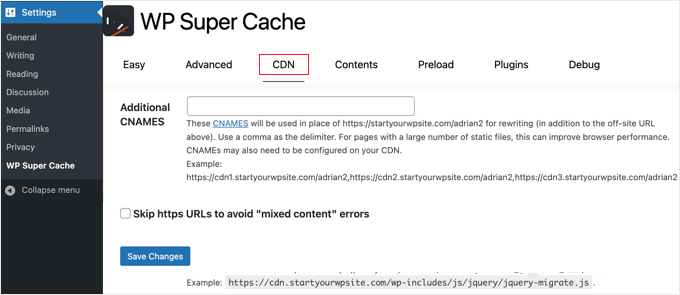
Teraz twoja witryna internetowa jest gotowa do serwowania statycznych treści z CDN.
Serwowanie witryn statycznych za pomocą WP Super Cache
Tryb wstępnego ładowania w WP Super Cache umożliwia tworzenie super pamięci podręcznej statycznych plików dla wszystkich twoich wpisów i stron oraz serwowanie statycznej witryny internetowej. W ten sposób twoje treści będą się szybko wczytywać za każdym razem, gdy ktoś przejdzie na twoją witrynę.
Plik statyczny super cache pomaga oszczędzać zasoby serwera, obsługiwać starą witrynę, która nie jest już aktualizowana, i poprawiać szybkość witryny poprzez serwowanie tylko statycznych treści.
Aby rozpocząć, przejdź do karty “Preload” we wtyczce WP Super Cache. Następnie można ustawić czas odświeżania wstępnie załadowanych plików pamięci podręcznej.
Domyślnie wtyczka ustawia ten czas na 600 minut, ale możesz go zmniejszyć, jeśli publikujesz wiele artykułów dziennie.
Pamiętaj, że wstępne wczytywanie całej witryny WordPress zajmuje trochę czasu i zużywa dużo zasobów twojego serwera. Możesz pozostawić wartość 0, jeśli nie chcesz, aby twoje pliki statyczne kiedykolwiek wygasły, chyba że ręcznie odświeżysz pamięć podręczna.
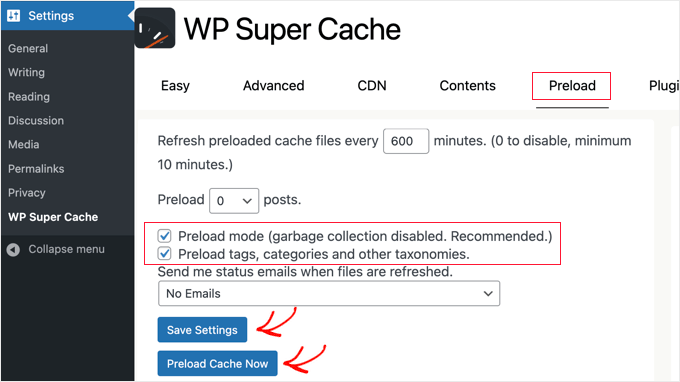
Następnie upewnij się, że zaznaczone są pola “Tryb wstępnego ładowania (wyłączone odśmiecanie. Zalecane)”. Możesz również włączyć wstępne ładowanie dla różnych tagów, kategorii i innych taksonomii w twojej witrynie internetowej.
Wtyczka oferuje również opcję otrzymywania powiadomień e-mail za każdym razem, gdy twoje pliki są odświeżane. Domyślnie używane jest ustawienie “Brak e-maila”, ale można je zmienić, wybierając opcję z menu rozwijanego.
Gdy skończysz, zapisz swoje ustawienia, a następnie kliknij przycisk “Załaduj pamięć podręczną teraz”.
Przewodniki ekspertów na temat pamięci podręcznej WordPress
Mamy nadzieję, że ten przewodnik pomógł ci skonfigurować WP Super Cache na twoim blogu WordPress. Być może spodoba ci się kilka innych artykułów związanych z pamięcią podręczną WordPress:
- Jak łatwo naprawiono ostrzeżenie o buforowaniu przeglądarki w WordPressie?
- Jak wyczyścić pamięć podręczna w WordPress (krok po kroku)
- Najlepsze wtyczki WordPress do pamięci podręcznej, aby przyspieszyć twoją witrynę internetową
- LiteSpeed Cache vs. WP Rocket – który z nich jest lepszy?
- Jak prawidłowo zainstalować i skonfigurować WP Rocket w WordPress
- Jak zainstalować i skonfigurować W3 Total Cache dla początkujących
- Najlepszy przewodnik po zwiększaniu szybkości i wydajności WordPressa
- Jak przyspieszyć wydajność WooCommerce
If you liked this article, then please subscribe to our YouTube Channel for WordPress video tutorials. You can also find us on Twitter and Facebook.





Anze
Hey; I have a question – so preload mode enabled does not deletes old cached files – but does that means then when preloaded files are refreshed, the old ones are deleted and replaced, or does it just adding files, which would mean space on server would eventually run out?
WPBeginner Support
When the page is preloaded a new time, the old preloaded version would be deleted and replaced.
Admin
James Omeke
Thanks so much . This was very helpful.
I got my website up and running now
WPBeginner Support
You’re welcome, glad our guide was helpful!
Admin
Mike Royden
Plug in installed, but can’t get past this;
Permalink Structure Error
A custom url or permalink structure is required for this plugin to work correctly. Please go to the Permalinks Options Page to configure your permalinks.
I have gone to the Permalinks Options Page to configure your permalinks, but can’t see where I’m going wrong. Going round in circles, please help. Thanks
WPBeginner Support
You would want to ensure your permalinks are not set to plain for that error. We recommend using the Post name structure.
Admin
Mike Royden
Sorted! Many thanks for your advice and taking the time to reply. Cheers.
Katherine
I’m trying to set up this plug in to get the best results, and I’m not tech-savvy at all. Your Wp advanced cache set up section is not the same as the current plugin advanced options.
WPBeginner Support
Thank you for letting us know, we will be sure to take a look into this and update our article when able.
Admin
Simon
I was able to speed up my homepage significantly but unfortunately it only worked for the homepage. The subpages like i.e. ‘Services’ are still really slow.
What could be the problem?
WPBeginner Support
You would want to run a speed test for that using our guide below to figure that out:
https://www.wpbeginner.com/beginners-guide/how-to-properly-run-a-website-speed-test-best-tools/
Admin
Rainey
Unable to activate the plugin. I get a warning message that a .php file already exists and I should manually delete it before using the plugin. Since I am not a techie I do not know where to go to delete the file. If you could put language in your update to the tutorial to guide us would be really helpful.
WPBeginner Support
For that error, you may want to follow our guide below:
https://www.wpbeginner.com/wp-tutorials/how-to-fix-destination-folder-already-exists-error-in-wordpress/
Admin
Paul
This post is dated. When will this post be updated? Would like to know the current status of WP Super Cache?
WPBeginner Support
Thank you for letting us know, we do not have a specific date that content will be updated but we will take a look into updating this article
Admin
Nic
Is there a way to export settings once you get done?
WPBeginner Support
At the moment WP Super Cache does not have a built-in option to export settings.
Admin
ShoaiB
Thank you for this Awesome Guide.
I’m using WP Super Cache (Version 1.7.0 ). In the above tutorial, many features are not included. plz, Update Post.
WPBeginner Support
Thank you for your request, we will look into updating the post
Admin
Christopher
not as easy as described…
A custom url or permalink structure is required for this plugin to work correctly. Please go to the Permalinks Options Page to configure your permalinks.
WPBeginner Support
Thank you for reminding us of that, we’ll be sure to look into updating the article for clarification.
Admin
Ana
Hello Support!
Thank you for all your work, I’m a complete newbie and without you, I don’t know how I’d manage.
I’m confused as regards what off-site URLs and CNames are, so I’m unable to fill in that in the form. Do I have to refer to somewhere on my page to find out or do I just create it my indicating something?
Just in case it affects somehow I’d like to inform that I run a multisite.
Thank you so much & hope you can help me,
Ana
WPBeginner Support
Hi Ana,
The off site URL is the URL of your CDN location and CNames are different pullzones you have created on your CDN server. If you are not using a CDN, then you don’t need to make any changes to these settings.
Admin
krishna
can i use this plugin for testing in localhost ??
i installed this plugin in localhost and in “Cache Contents” nothing cached
displaying this …
WP-Cache (0KB)
0 Cached Pages
0 Expired Pages
WP-Super-Cache (0KB)
0 Cached Pages
0 Expired Pages
is it because i can’t use cache plugin in localhost or some other issue ?
Hardik
There is nothing called MOD_REWRITE. Everything from that step seems completely different. Please update the tutorial.
Mike
No matter what settings I use Pingdom still gives me an F and says “The following cacheable resources have a short freshness lifetime. Specify an expiration at least one week in the future for the following resources:” and I see and “expiration not specified” message in the details. Am I missing a setting?
Akshay
Hi Team ,
Thanks for the amazing article .
I have installed WP Super Cache with cloudflare (newbie blogger).
Can you please help me, how can I integrate cloudflare with WP super cache .
I did not found any articles or vidoes for the same .
I thought of installing WP Total , but it has not releasedthe update for recent wordpress version 4.8.1
Thank You
Sumaiya
Hi, I wanted to speed up my site. I used this guide and customized the settings as you shown. But before installing this plugin I tested my site speed it was 4.20 sec. But after installing I check it was 6.78 sec. Why is it like this? please guide me well.
WPBeginner Support
Hi Sumaiya,
Please test it again. If the result persists, then deactivate the plugin.
Admin
Rajeev jaiswal
hello sir, I’m trying to integrate js and CSS code elements in twenty-seventeen WordPress theme. I use enqueue methods but it does not work, so suggest me to all about.
Sara
I just downloaded WP Super Cache and the “Advanced” Page doesn’t have the same setup (or some of the same options!) as your screenshot and instructions. Are those dates, or did I somehow end up with an older version of the plugin?
Carrie
Same here, my settings are different.
Abner
Hi guys – Thanks for sharing this. I am using wp super cache and my wordpress is 4.0.1. At first, i don’t have any problem. Until recently, having a problem. My post did not appear on my website. I tried to put the caching off and my post appear. After that, I put the caching on again. My workaround was after posting article to my website, I will put my caching off to appear the post in my website, then after a few minutes, I will put the caching to on.
Few weeks doing that, and now, when I put the caching on, my post will disappear again to my website. As of now, my caching is still off.
Thanks and hope you can help me.
WPBeginner Support
Hi Abner,
Seems like WP Super Cache is not clearing the cache when you publish new content. Please see our article on how to clear cache in WordPress.
Admin
Mark Layton
Hello Support,
Thank You for your help with this issue while trying to install WP Super Cache.
Here is a copy of issue :
Warning! Could not update /var/www/website/wp-config.php! WPCACHEHOME must be set in config file.
Warning! /var/www/website/wp-content/advanced-cache.php does not exist or cannot be updated.
1. If it already exists, please delete the file first.
2. Make /var/www/website/wp-content writable using the chmod command through your ftp or server software. (chmod 777 /var/www/website/wp-content) and refresh this page. This is only a temporary measure and you’ll have to make it read only afterwards again. (Change 777 to 755 in the previous command)
3. Refresh this page to update /var/www/website/wp-content/advanced-cache.php
If that doesn’t work, make sure the file /var/www/website/wp-content/advanced-cache.php doesn’t exist:
1. Open /var/www/website/wp-content/plugins/wp-super-cache/advanced-cache.php$wp_cache_file in a text editor.
2. Change the text CACHEHOME to /var/www/website/wp-content/plugins/wp-super-cache/
3. Save the file and copy it to /var/www/website/wp-content/advanced-cache.php and refresh this page.
Cannot continue… fix previous problems and retry.
Already use your Envira Gallery and WP Forms and those are fantastic.
Should I just use W3 Total Cache instead?
Thank You so much for your help.
Mark Layton
WPBeginner Support
Hey Mark,
You can try following the instructions shown in WP Super Cache. If you find them too complicated, then you can try W3 Total Cache. Good luck
Admin
sheikave Jhurreea
Initially my website was loading for under 8 seconds which is pretty bad. But using your tutorial I was able get 90/100 for desktop performance.
But the mobile platform it remained 74/100. Could you suggest some resources where I could look up too or what is your suggestion.
WPBeginner Support
Hey Sheikave,
Congrats! That’s impressive. You may also want to see our guide on how to fix render-blocking JavaScript and CSS in WordPress.
Admin
Greg
Hi, I’d like to know whether your guidance to choose mod_rewrite to serve cache files still stands as opposed to using PHP or Legacy Caching. I notice since you published your article, WP Super Cache have changed their own recommendation from mod_rewrite to PHP.
Thanks in advance!
Greg
Dillon
Hi there. I’ve followed this tutorial to a T, and for the most part, everything works correctly, but I’m having two problems. First, when I make changes, they don’t appear on the site if I’m logged in. If I log out, they appear just fine. Second, I’m working on a WPMU network, and I only have the plugin installed on one site. But it’s caching the other sites on the network as well. How do I stop it from doing that? Thanks!
Belayet Hossain
This is an awesome guideline for new users.
It helped me a lot.
Thanks from the core of heart.
Sarah
Hi,
I followed your steps because my site was taking over 5s to load but after setting up the WP Super Cache my site wouldn’t load. At all. It was basic HTML – no content, no pictures, just the header…
So, I guess I’m wondering if there’s a laymen’s guide to literally all the terms you use cause I don’t understand websites or programming and I have a website for a start-up NGO so can’t really pay for any help at this point.
Or maybe you could direct me somewhere that will help me understand all this better? I’m a complete novice and confused easily!
Help!
Pedro Moreira
Hello,
I have a “conceptual doubt” about WP Super Cache, that I didn´t see answered neither in your site neither in other sites.
The question is: the structure of my site is finished. In basic terms, it is mainly a site of videos of football, which means that from this day on I will gradually add posts (that include the videos that I refered) and pages (of the teams).
Since that this will be a long and permanent process, I need right now to speed up my site because nowadays is very slow.
My doubt is: when I install and configue this plugin, what does that mean in terms of the updates that I will do in my site (post and pages that I add)?
I mean, if I cache the site today and tomorrow I add a new page or post, what do I have to do in order that these pages or posts will be also cached? – do I just have to require an update of the plugin? If so, how do I do that, is it possible to define that the plugin will update the cache for example once a week?
Thank you!
Best regards.
Bogdan
If i don„t use set up the CDN ,the wp super cache will be work properly ?
WPBeginner Support
Yes, it will work even without CDN.
Admin
Herman
I’m getting an error on the first step where you need to click on caching on and update. You mentioned the following in your article:
“WP Super Cache will fetch your WordPress site twice and will compare the time stamps of both pages. If the both time stamps match then this means that caching is working on your site now.”
This is the place where I get the error. I get a message that says:
Fetching to prime cache: OK
Fetching first copy of FAILED
Fetching second copy of : FAILED
I would be glad if you could help me out.
Sofor
Thank you so much, It works great for me.
Teddy
My site is a coupon site, so code is included on the coupon so it prints out by itself without lots of other junk that is on the page. If I use WP Super Cache, will that code be lost because it’s now a static page? Will people still be able to click on the coupon to print just the coupon?
WPBeginner Support
Hi Teddy,
You will have to test it out first on your computer or in a staging environment.
Admin
Alex
Thanks so much for the the help. Do i have to create a cname record to use the CDN service in WP super cache. Thanks
Stefan Andonov
Hi,
How to preload for several languages, I am using qtranslate, that seems impossible, right?
10x
Stefan
John Johnson
This is an ecommerce site using Exchange from iThemes. With WP Super Cache activated certain pages that need to be refreshed don’t get refreshed i.e. Empty Cart. When you Empty Cart it comes back with the same content or in other words it appears unemptied.
When I deactivate WP Super Cache the problem disappears. It was suggested that I Whitelist the pages that shouldn’t be cached. I am uncertain about how to do that. Any help would be appreciated.
Regards,
John
Dajuan
WP Beginner Staff, when a theme update is applied, or when other plugin updates are made, is WP Super Cache alerted to create new cached versions? Or does the plugin wait until “Expiry Time & Garbage Collection” or a manual cache deletion?
Iosif
Hello,
I am using WP Super Cache, but it seems that my images don’t get cached. Any ideas on how to configure this?
I did have a lazy load plug-in, but it conflicted with my theme, so I deactivated it…
shubhendu
I have just install wp super cache plugin by reading your article but nor js,css and image is not loading at my blog…plz help my site address is
If you dont want to publish is comment because i include my site link PLEASE reply to my email id.
Thanks.
WPBeginner Support
Seems like you have already resolved the issue.
Admin
madhavi jha
hi , i am regular reader of your site , i have setup WP Super Cache plugin as you guide in your blog , but its not working its show only 20/100
please guide me ,i have been tried to solve this problem since last 2 days , please guide me .
nitai roy
Hi,
I followed as you mentioned here. Everything has done perfectly but I could not find this option: “Enable Compression in WP Super Cache:”
Where is it please?
Also, Now how can I know whether it is working perfectly or not?
Thank you very much.
Patel Shoeb
How to Install and Setup WP Super Cache with CloudFlare CDN?
kurakaniz
after updating the plugin it says “.htaccess file may need to be moved” and this error too
A difference between the rules in your .htaccess file and the plugin rewrite rules has been found. This could be simple whitespace differences but you should compare the rules in the file with those below as soon as possible. Click the ’Update Mod_Rewrite Rules’ button to update the rules.
what to do please help
Ron
Same problem here.Anyone help
stephen
I installed everything just as you said but I am still getting 52sec load time and if I tried using gtmetrix I get an error saying the URL does not appear to be an HTML.home page . please help site is
Megan Good
This article was very helpful, and I was able to troubleshoot my issues based on your suggested settings. Thank you for the info!
Omprakash Jaiswal
wp super cache does not work
Permlink Structure Error
A custom url or permalink structure is required for this plugin to work correctly. Please go to the Permalinks Options Page to configure your permalinks.
Hammad
Thank you for your suggestions, I’m trying to apply these settings on my website now. Can you please advise if wp super cache supports minify settings.
I had wp3 total cache and had a score of 97/81 on gtmetrix, after installing wp super cache my score decreased to 82/68.
Imran
Was looking for some great guide for super cache plugin. Now I will try it on my test site.
Thanks for such a nice tutorial
Robert Connor
Some great tips-now i need to go back and fix my site
User
How do I get it to work for Mobile without changing the theme?
cezars
Any info for Rejected User Agents list from the plugin ?
herb
Installed it and got a lower grade E/D on Gtmetrix…switched to W3TC and it gave me and A/B grade.
efiga
Hi
i have a little question , when using this plugin to cashe pages , the google adsense ads will be cashed too ? ,it will show the same ads ?
thank you in advance
WPBeginner Staff
No your Google Ads will not be cached.